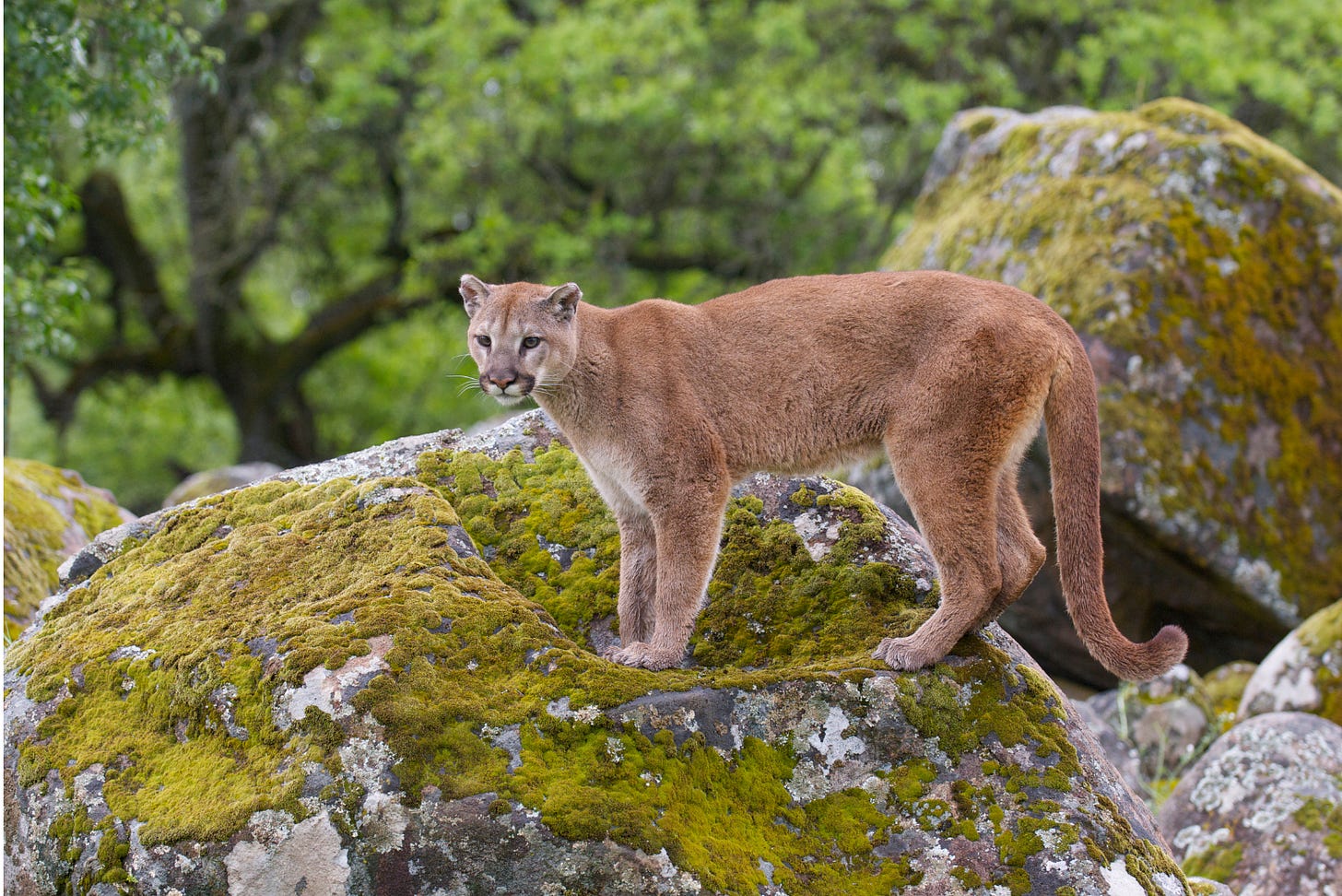Here are my top 5 environmental good news stories of the week. Enjoy!
California is building the world’s largest wildlife crossing
This week, workers began laying soil for the Wallis Annenberg Wildlife Crossing — the world’s largest wildlife overpass. Located in Agoura Hills, California, the structure towers over Route 101, spanning 10 lanes of traffic. Not only will the crossing reduce the number of animal-vehicle collisions, but it will serve as an ecological corridor.
When Route 101 was built in 1926, it fragmented important habitat, isolating wildlife populations. As a result, species like the mountain lion have suffered from limited genetic diversity. The crossing will link these fragmented habitats, allowing animals to expand their ranges and interbreed.
The project was first proposed more than 30 years ago, and construction finally began in 2022. On Monday, workers began covering the structure with a soil mixture carefully chosen to support native plants. It will take several weeks and 6,000 cubic yards of soil to cover the area. After the soil is in place, a team will plant native vegetation to provide food and cover, making the corridor feel like a natural extension of the landscape. Completion is anticipated next year.
Toronto’s Don River has been set free
Toronto’s Don River was long confined to concrete channels, with its mouth at Lake Ontario an industrial wasteland of factories and port facilities. Now, thanks to an ambitious ecological restoration project, the river has returned to its natural state. A new outlet was carved out, allowing the river to meander naturally and overflow riverbanks during heavy rainfall — without causing damage to surrounding developments.
Lining the riverbanks is the newly unveiled Biidaasige Park, covering roughly 60 acres at the river mouth. It’s the largest Toronto park to open in a generation, created both for flood protection and biodiversity. The park provides habitat for native plants and wildlife, including Bald Eagles and fish species not seen for 80 years.
With over 14,000 new housing units planned for this area, planners hope the project will foster a new relationship between urban residents and nature, offering a model for resilience in the face of climate change.
Nepal is charging ahead with electric vehicle adoption
Nepal is charging ahead with its transition to electric vehicles. In 2024, more than 70% of new passenger cars sold in the country were electric. More than 13,000 electric cars were imported between July 2023 and July 2024, a huge leap from just 250 vehicles four years prior. Public transportation is shifting as well, with hundreds of electric minibuses serve mountain communities.
This surge is largely driven by Kathmandu’s severe air pollution, with fine particulate matter often measuring 10 to 20 times WHO safety guidelines. According to World Bank analysis, transport accounts for about 25% of this dangerous air pollution. The shift to EVs also supports Nepal’s energy independence: the country imports all of its petroleum products. EVs, on the other hand, charge with domestic hydroelectricity — both reducing carbon emissions and the reliance on fuel imports.
Government officials aim for 90% of private vehicle sales and 60% of public transport sales to be electric by 2030. Policies have played a central role in this transition, with generous financing and lower import taxes on electric cars vs gas-powered. These measures, coupled with reliable hydroelectric power and expanding charging infrastructure, are making electric cars both affordable and practical for many Nepalis.
Organizations are supplying hope in a bar of soap
Around the world, billions of people lack basic handwashing facilities — including soap. Samir Lakhani witnessed this firsthand in Cambodia, when he saw a mother bathing her newborn with laundry detergent — the only suds available to her. This eye-opening experience prompted Lakhani to found Eco-Soap Bank, an organization that recycles used hotel soap and unsellable factory bars for distribution to communities in need.
Since its inception in 2014, Eco-Soap Bank has diverted over 14 million pounds of soap from landfills, building a network of more than 1,000 hotels. The organization has since branched into diverting factory waste, which could prevent roughly 44 million tons of CO2e emissions and save over 29 million gallons of water annually.
Similar initiatives have taken root globally. Australia’s Soap Aid has kept over 380 metric tons of soap out of landfills since 2011, processing and redistributing it to communities in need. In Canada, Victoria-based Soap for Hope collects, sanitizes, and repurposes hotel soap and toiletries, supplying over 500 service organizations in British Columbia and Alberta. To further reduce landfill waste, soap containers are either repurposed or recycled.
Oregon to house the largest solar-plus-storage facility in the U.S.
The Sunstone Solar project in Oregon is set to become the largest solar-plus-storage facility in the United States, combining expansive solar arrays with advanced battery technologies to store and deliver renewable energy more reliably. With up to six hours of energy storage—well above the industry norm—the project effectively tackles the challenge of solar power intermittency and positions Oregon as a leader in innovative clean energy solutions. As battery costs drop and longer-duration options become more affordable, this approach is paving the way for increased renewable integration across the electric grid.
Beyond its technological advancements, the project promises substantial economic and environmental benefits, creating jobs and supporting Oregon’s goal of 100% carbon-free electricity by 2040. By investing in local agriculture and balancing land use with community needs, the Oregon Solar Plus system serves as a model for sustainable energy development, demonstrating how thoughtful planning and collaboration can address challenges while advancing a cleaner, more resilient energy future.




Thank you for this info about the park happening in my own city lol (Toronto) I live on the other side of our huge city and didn’t know about this! 🙈